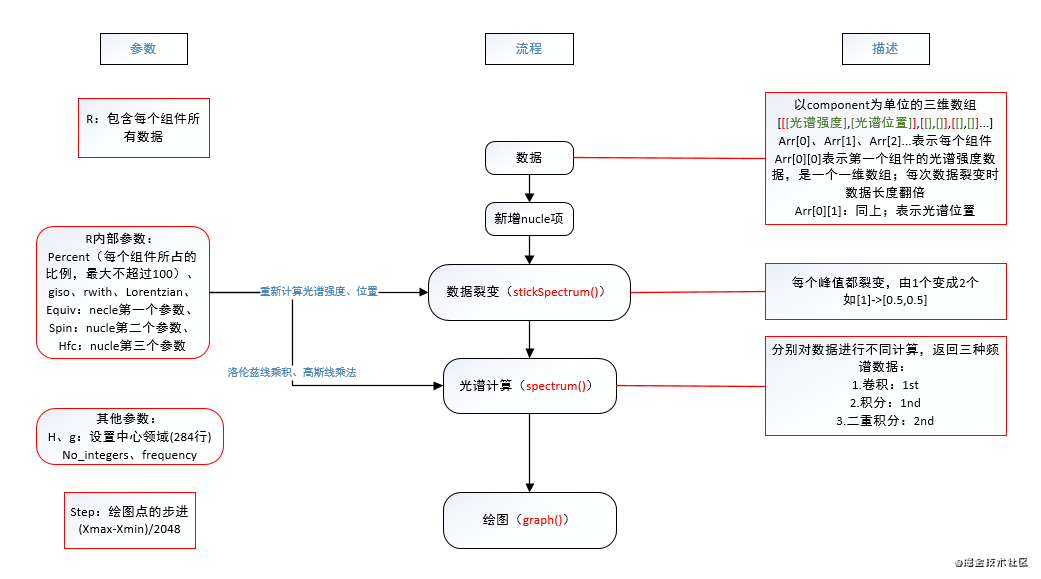这篇文章运用简单易懂的例子给大家介绍波谱拟合的实现——Vue篇,内容非常详细,感兴趣的小伙伴们可以参考借鉴,希望对大家能有所帮助。
主页面-功能介绍

波谱拟合用来对某种材料或物质的谱图进行识别和分析,每种物质可以有多种成分,每种成分用component1、component2...表示,用Add another component和Remove component来控制每种成分的增加和删除,每种成分由多种原子核构成,即nuclei,用Add nucleus和Remove nucleus来控制每种成分内原子核数量,每新增一个原子核,波谱就会分裂一次,谱峰数量由(1->2->4->8...)依次分裂。另外可以通过更改默认参数,改变波谱形态,成分参数中:Relative amount表示每种成分占绘图分量的百分比,百分比之和不超过100,giso用来计算分裂的中心位置,LineWidth用来控设置谱峰到谱谷的宽度,%Lorentzian表示谱峰形态,一共两种形态,高斯和洛伦兹,两者之和为100;原子核参数:No of equivalent nuclei用来改变原子核个数,如果一种成分内包含很多个一模一样的参数时,就可以通过改变这个参数实现,Nuclear spin用来改变原子核种类,Hyperfine用来设置分裂后两峰之间的宽度。
再来一张图:

每种成分数量和参数、每种成分内每种原子核数量和参数设置好后,对数据进行处理,由三种结果,卷积、积分、二重积分,那就来看看数据的处理逻辑吧~

从数据流角度,主要进行三步处理:数据->数据裂变->光谱计算->绘图,左边是算法实现所需的参数、右边是对数据及每个步骤的描述。
代码实现
遇到一个坑,一开始写demo的时候用的vue+Ant design of vue,在select等其他组件的使用上都是正常的,但是在input number中就很变态了,给input number绑定的change事件,用户在输入两位以上数据的时候,change事件会触发两次!!!想避免这个问题,于是用blur事件,问题又来了,因为这个页面中组件的生成和删除需要动态渲染,并且根据前面的介绍很容易知道组件的渲染是有两层结构的,那么在用户进行点击或输入操作的时候,就需要传递一个参数(用来定位是哪个component以及每个component下面对应的某一个nucle等等),能力有限( ╯□╰ )目前我没有找到解决办法,于是转elementUI框架。
组件的动态渲染用了一个比较巧妙的办法,一开始我打算用render来写,后来从部门大神那里学到通过遍历列表进行渲染,脑子之间还是有差距的。。。
<div v-for="(Con, i) in componentList" :key="Con[i]"><strong>Component {{i+1}}.</div>同理原子核的动态渲染也是这么实现的:
<div v-for="(li, j) in nucleusList[i]" :key="li[j]">{{j+1}}. No of equivalent nuclei:</div>然后每次增加和删除只需要操作数组列表的长度即可~
各参数的绑定:component中参数均使用一维数组,chenge事件需传递一维数组的下标,component内的nucleui均使用二维数组,change事件需传递二维数组的下标。
以上介绍参数定义,接下来是数据处理:
// 首先计算裂变数据
stickspectrum (w) {
// console.log('组件信息', w)
const stick = new Array(2) // 返回包含stick[0]的stick光谱数组,stick[1]是位置
stick[0] = new Array()// 光谱强度
stick[1] = new Array()// 光谱位置
stick[1][0] = this.h * this.frequency / (this.r[w].g * this.mu)
for (var j = 0; j < this.r[w].equiv.length; j++) {
// console.log('stick[0].length', stick[0].length) //分裂后的光谱数据长度
for (var i = stick[0].length - 1; i >= 0; i--) {
stick[0][i] /= Math.pow((2 * this.r[w].spin[j] + 1), this.r[w].equiv[j])
stick[1][i] -= this.r[w].equiv[j] * this.r[w].spin[j] * this.r[w].hfc[j]
for (var k = 0; k < 2 * this.r[w].equiv[j] * this.r[w].spin[j]; k++) {
stick[1].splice(i + k + 1, 0, stick[1][i] + this.r[w].hfc[j] * (k + 1))
stick[0].splice(i + k + 1, 0, 0)
}
for (var k = 0; k < this.r[w].equiv[j]; k++) {
for (var m = i + 2 * this.r[w].spin[j] * k; m >= i; m--) {
for (var ii = 0; ii < 2 * this.r[w].spin[j]; ii++) {
stick[0][m + ii + 1] += stick[0][m]
}
}
}
}
}
return stick
},// 再对裂变后的数据进行光谱计算
spectrum (stick) {
let xmin = Infinity; let xmax = 0
for (var k = 0; k < this.r.length; k++) {
xmin = Math.min(Math.min.apply(Math, stick[k][1]) - 10 * this.r[k].width, xmin)
xmax = Math.max(Math.max.apply(Math, stick[k][1]) + 10 * this.r[k].width, xmax)
}
const tmp = xmax - xmin
xmax += tmp * 0.05
xmin -= tmp * 0.05
const step = (xmax - xmin) / (this.No_integers - 1)
for (let i = 0; i < this.No_integers; i++) {
this.XY[0][i][0] = xmin + step * i
this.XY[0][i][1] = 0
this.XYint[0][i][0] = this.XY[0][i][0]
this.XYint[0][i][1] = 0
this.XYdoubleint[0][i][0] = this.XY[0][i][0]
this.XYdoubleint[0][i][1] = 0
}
for (let k = 0; k < this.r.length; k++) { // 分量累加
const sticks = new Array(this.No_integers)
for (var i = 0; i < stick[k][0].length; i++) {
var j = Math.round((stick[k][1][i] - xmin) / step)
sticks[j] = sticks[j] ? sticks[j] + stick[k][0][i] : stick[k][0][i]
}
const tmp = new Array(this.No_integers)// 第一种光谱绘图位置数据
let ind = 0
for (var i = 0; i < this.No_integers; i++) {
if (sticks[i]) { // 建立峰值索引——sticks[i]===1即峰值所在。
tmp[ind] = i
ind++
}
}
const tmpint = new Array(this.No_integers) // 用来保存每个分量的积分
const tmpdoubleint = new Array(this.No_integers) // 用来保存每个分量的二重积分
for (var i = 0; i < this.No_integers; i++) tmpint[i] = 0
tmpdoubleint[0] = 0
const rwid = Number(this.r[k].width)
const rwid2 = Math.pow(rwid, 2)
const lortmp = Number(this.r[k].percent) * Number(this.r[k].lor) / 100 * Math.sqrt(3) / Math.PI // 洛伦兹线乘积
const gaustmp = Number(this.r[k].percent) * (100 - Number(this.r[k].lor)) / 100 * Math.sqrt(2 / Math.PI) // 高斯线乘法器
for (let i = 0; i < this.No_integers; i++) {
for (let j = 0; j < ind; j++) {
const delta = this.XY[0][i][0] - this.XY[0][tmp[j]][0]
const delta2 = Math.pow(delta, 2)
if ((rwid > step && Math.abs(-0.5 * rwid - delta) < 0.5 * step) || (rwid < step && -0.5 * rwid - delta > 0 && -0.5 * rwid - delta < step)) {
this.XY[0][i][1] += sticks[tmp[j]] * (lortmp * 0.5 / rwid2 + gaustmp * 2 / Math.sqrt(Math.E) / rwid2)
} else if ((rwid > step && Math.abs(0.5 * rwid - delta) < 0.5 * step) || (rwid < step && delta - 0.5 * rwid > 0 && delta - 0.5 * rwid < step)) {
this.XY[0][i][1] -= sticks[tmp[j]] * (lortmp * 0.5 / rwid2 + gaustmp * 2 / Math.sqrt(Math.E) / rwid2)
} else {
this.XY[0][i][1] += sticks[tmp[j]] * (gaustmp * (-4) / rwid / rwid2 * delta * Math.exp(-2 * delta2 / rwid2) + lortmp * (-delta) * rwid / Math.pow((delta2 + 3 / 4 * rwid2), 2)) // 其他情况下的正常计算,高斯+洛伦兹
}
this.dataarray = [this.XY, this.XYint, this.XYdoubleint]
tmpint[i] += sticks[tmp[j]] * (gaustmp * Math.exp(-2 * delta2 / rwid2) / rwid + lortmp / 2 / rwid / (0.75 + delta2 / rwid2)) // 高斯+洛伦兹积分-明确计算以避免积分误差
}
}
for (let j = 1; j < this.No_integers; j++) {
tmpdoubleint[j] = tmpdoubleint[j - 1] + step * (tmpint[j] + tmpint[j - 1]) / 2
} // 二重积分
// console.log('二重积分', tmpdoubleint)
const mm = tmpdoubleint[this.No_integers - 1] / Number(this.r[k].percent) // 有多少积分高于理论(只发生在非常尖锐的线)
for (let j = 1; j < this.No_integers; j++) {
this.XYdoubleint[0][j][1] += mm > 1 ? tmpdoubleint[j] / mm : tmpdoubleint[j] // 第三种频谱数据 如果二重积分高于理论,将其标准化
this.XYint[0][j][1] += tmpint[j] // 第二种频谱数据
}
}
// console.log('XYint', this.XYint[0])
},关于波谱拟合的实现——Vue篇就分享到这里了,希望以上内容可以对大家有一定的帮助,可以学到更多知识。如果觉得文章不错,可以把它分享出去让更多的人看到。
免责声明:本站发布的内容(图片、视频和文字)以原创、转载和分享为主,文章观点不代表本网站立场,如果涉及侵权请联系站长邮箱:is@yisu.com进行举报,并提供相关证据,一经查实,将立刻删除涉嫌侵权内容。